Schema markup, also known as structured data, is code you add to your website that helps search engines better interpret your content.
Table of Contents
What Is Schema Markup in SEO?
By including schema markup, you make your content eligible for additional details to appear in search results. For example, search engines like Google may show star ratings, pricing, or whether a product is currently available.
These enhanced search listings are referred to as rich snippets.
When rich snippets appear, searchers can quickly find important information right from the search results page.
For instance, Dell showcases schema markup on product pages for computers, monitors, and more. Google can then display info like price range, product status, delivery costs, and other helpful details in Dell’s search listing.

Keep in mind, adding schema markup won’t automatically guarantee rich results. Ultimately, Google makes the decision on whether to display these enhanced formats.
Why Is Schema Markup Important for SEO?
Schema markup plays a valuable role in SEO because it gives search engines deeper context about your site, helping them surface your pages for more relevant queries.
Structured data also improves eligibility for richer, more attractive listings in search results.
This brings several advantages:
- Improved search visibility: Rich snippets make your entries more prominent in the results
- Higher click-through rate (CTR): Visually appealing details encourage more people to select your listing
- Better user experience (UX): Users can instantly access crucial information to determine if your page fits their needs
Without schema markup, your content likely appears as a basic blue link. If your competitors use schema and display rich results, your listing may not catch the visitor’s eye.
Common Types of Schema Markup
Google recognizes many types of schema markup, but you don’t need to use them all.
Below, we cover several of the most commonly applied types of schema.
Organization Markup
Organization schema markup provides search engines details about your company, including business name, logo, address, and contact information.
This markup may help your organization’s details appear in a knowledge panel in Google’s search results.
For example:
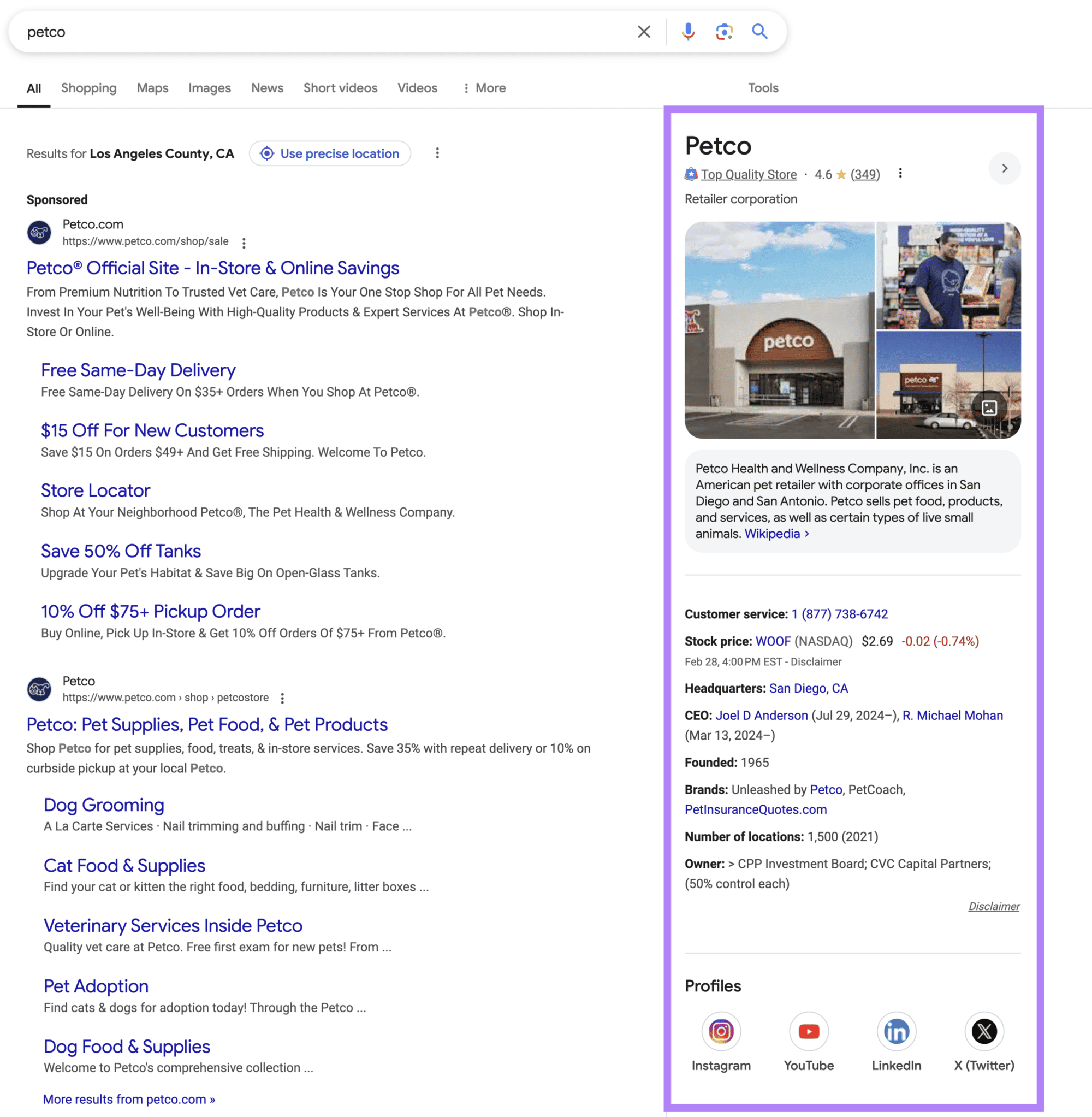
Product Snippets Markup
Product snippet markup is one of two main types of product schema markup—and it’s intended for pages where users cannot make a direct purchase, such as product reviews.
This schema tells search engines to consider displaying:
- Ratings and reviews: Compiled feedback from customers or experts
- Pros and cons: Product highlights and drawbacks (specific to editorial review pages)
- Price and availability: High-level pricing details without the ability to purchase on the page
Product snippet structured data is a good fit for editorial sites, affiliate marketers, and ecommerce platforms that highlight—but don’t sell—products.
For instance, when a tech review site publishes a thorough evaluation and implements product snippet schema, Google might show ratings, review highlights, and pros and cons in the results.

Merchant Listing Markup
Merchant listing markup is the other main product type, intended for pages where purchases are possible.
This markup can present purchase-specific information such as:
- Pricing and discounts: Current prices, sales, and promotions
- Stock availability: Indicating in-stock, out-of-stock, or backorder status
- Shipping and returns: Shipping options, costs, delivery times, and return policies
This is especially useful for ecommerce stores and online retailers that want shoppers to see purchase details right in the search listings.
Here’s how it can appear:
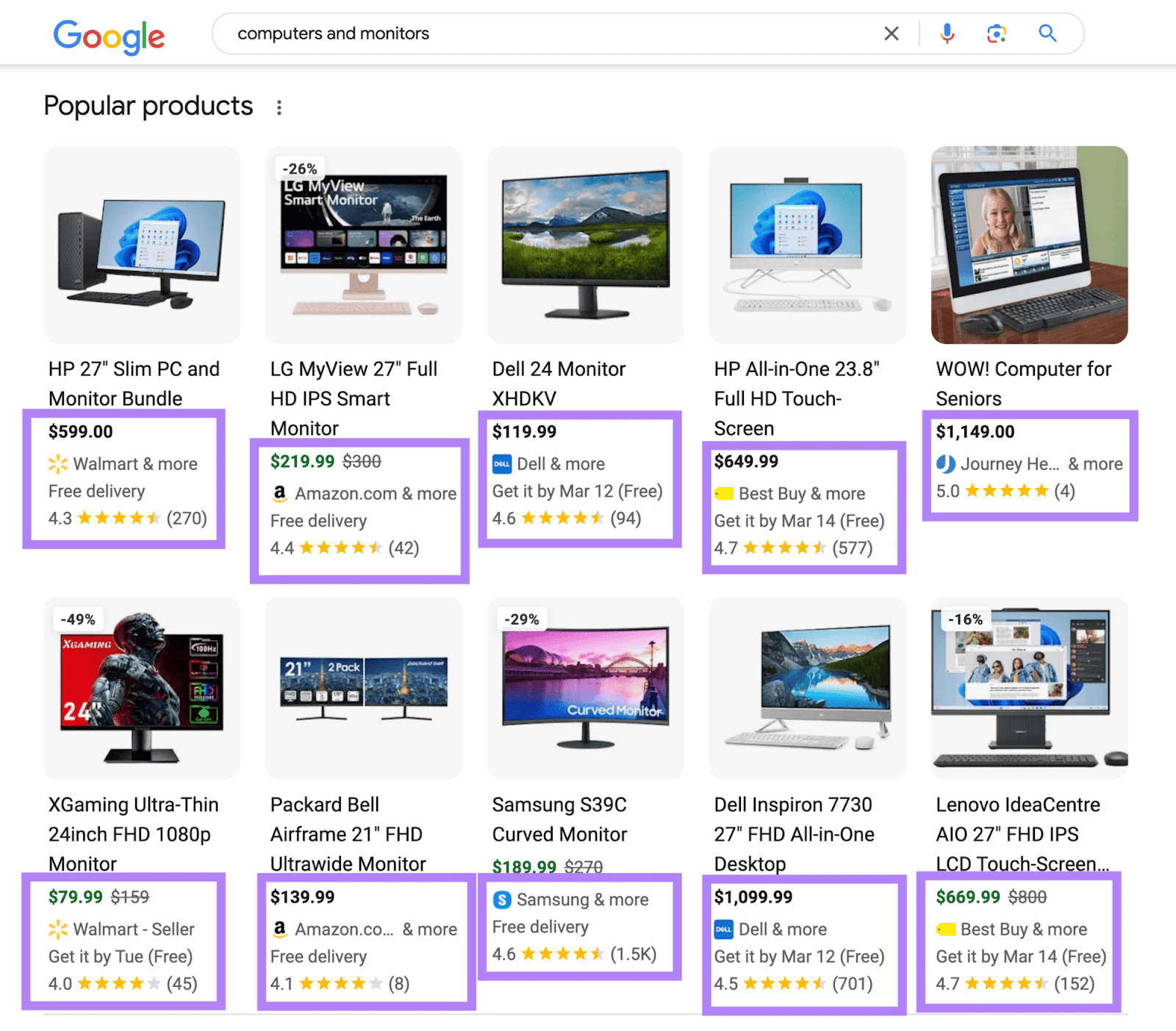
Review Schema Markup
Review schema allows you to showcase star ratings, summaries, and other review insights in search results.
Google supports reviews for a variety of structured data types including:
- Product
- Local business
- Movie
- Book
- Software app
- Recipe
There are two main ways reviews display:
First, a single rating is shown, listing the reviewer’s name with their review score:

Second, you might see an aggregated rating—this means an average score is displayed based on several user ratings (the total number is shown):

Article Markup
Article markup clarifies for search engines when your content is a news story, blog post, or sports article. Implementing this markup can make your articles eligible for rich snippets in Google Search and Google News.
It may influence how elements like the article headline, author, and publication date appear in search.
For example:

Further reading:
- How to Start a Blog: The Beginner’s Guide
- How to Write an SEO Blog Post: 11 Key Tips
Local Business Markup
Local business markup provides search engines with basic information about a brick-and-mortar business, like its address, phone number, and hours.
This type of schema is ideal for shops, restaurants, and service providers hoping to reach a local audience—even enhancing the profile that displays in Google Search and on Google Maps.
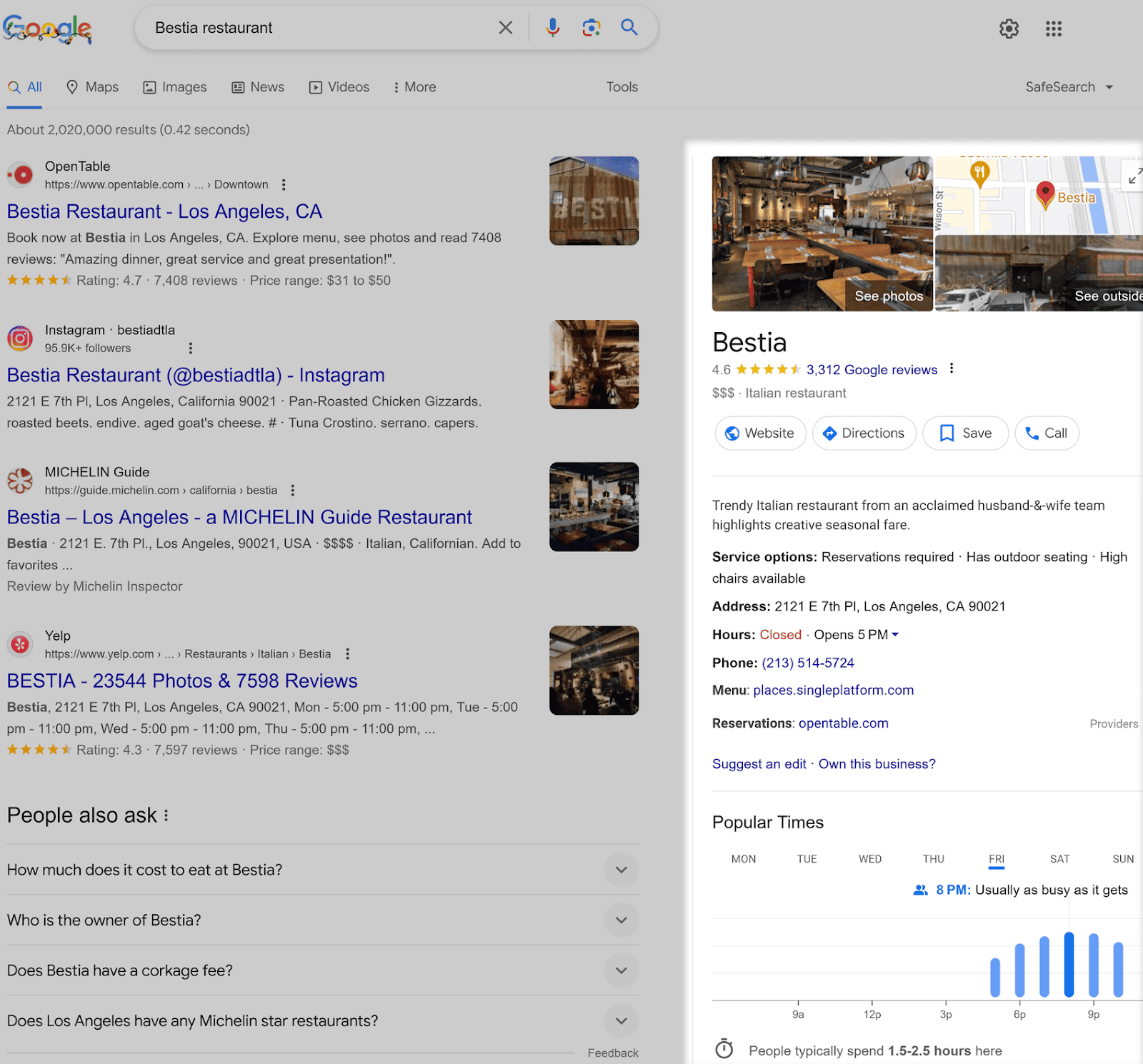
Further reading:
- Local SEO: What Is It & How to Do It
- The 10 Best Local SEO Tools
Schema Markup Language and Formats
Schema markup uses a standardized vocabulary provided by Schema.org so search engines can accurately interpret and display content as rich results.
This markup is inserted within the HTML code that forms the framework of a web page.
Google recognizes three main schema formats:
|
Format |
Description |
When to Use |
|
JSON-LD |
A JavaScript-based format within <script> tags, placed in the <head> or <body> of your HTML |
Recommended for most websites as it keeps the code tidy and is simple to maintain or troubleshoot |
|
Microdata |
Directly places schema attributes into your existing HTML elements |
Best if you want structured data closely tied to existing HTML |
|
RDFa |
Utilizes additional HTML attributes (often in <div> elements) for detailed semantic relationships |
Useful for advanced annotation or connecting to broader semantic web standards |
Here are examples of how the same structured data can be created using JSON-LD, Microdata, and RDFa:
JSON-LD goes inside <script> tags, making it easier to add and edit without impacting the main HTML layout.
<script type="application/ld+json">
{
"@context": "https://schema.org",
"@type": "Person",
"name": "John Doe",
"jobTitle": "Software Engineer",
"url": "https://example.com"
}
</script>Microdata places schema directly within HTML elements as shown below:
<div itemscope itemtype="https://schema.org/Person">
<p>Name: <span itemprop="name">John Doe</span></p>
<p>Job Title: <span itemprop="jobTitle">Software Engineer</span></p>
<p>Website: <a href="https://example.com" itemprop="url">Profile</a></p>
</div>RDFa is similarly embedded but uses a distinct set of attributes to express meaning:
<div vocab="https://schema.org/" typeof="Person">
<p>Name: <span property="name">John Doe</span></p>
<p>Job Title: <span property="jobTitle">Software Engineer</span></p>
<p>Website: <a href="https://example.com" property="url">Profile</a></p>
</div>All formats give search engines the structured context they need, but JSON-LD is the most widely used and preferred by Google.
How to Add Schema Markup to Your Website
Schema can be added directly to your site’s HTML or with the help of plugins if you’re using a content management system (CMS) like WordPress.
Here’s a step-by-step workflow for generating and adding schema markup:
1. Select Your Schema from Google’s Structured Data Markup Helper
Head to Google’s Structured Data Markup Helper, pick the schema type that suits your page, enter the page URL, and hit “Start Tagging.”
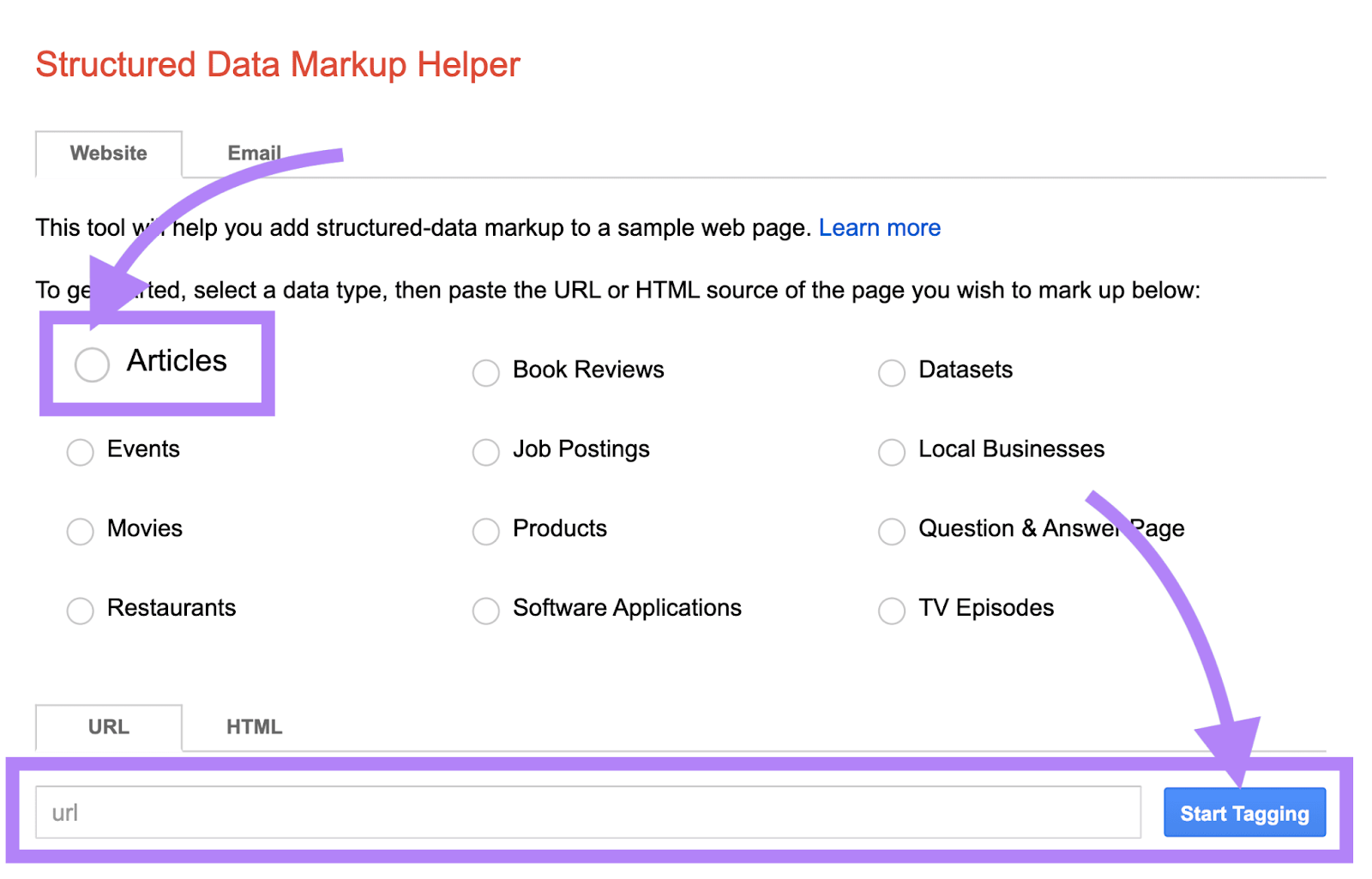
Your webpage will show up on the left, and items available for markup will populate on the right.
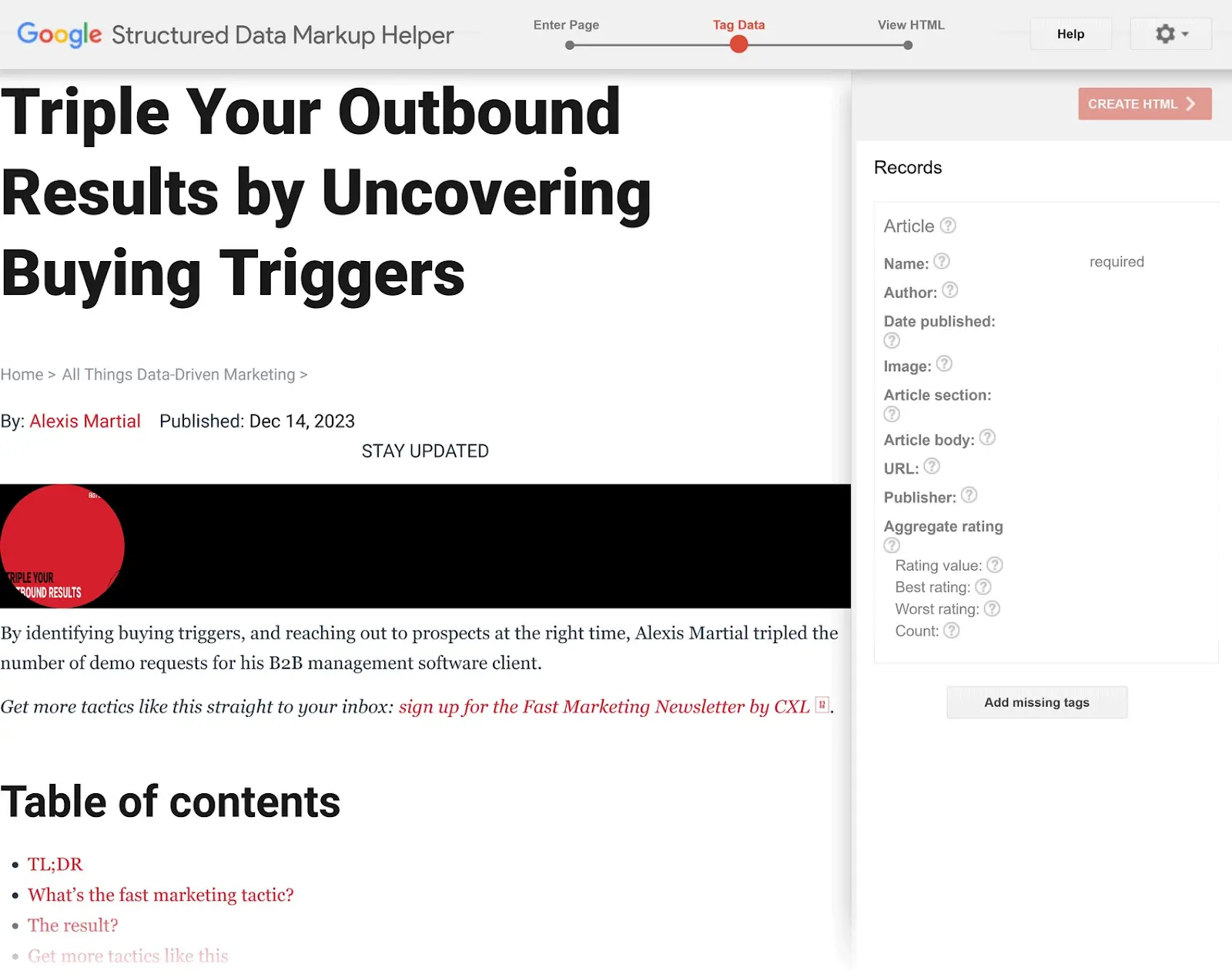
2. Mark Up Your Page
Highlight the sections you want to tag on your webpage within the tool.
For example, with an article, highlight the headline and choose “Name” from the menu.
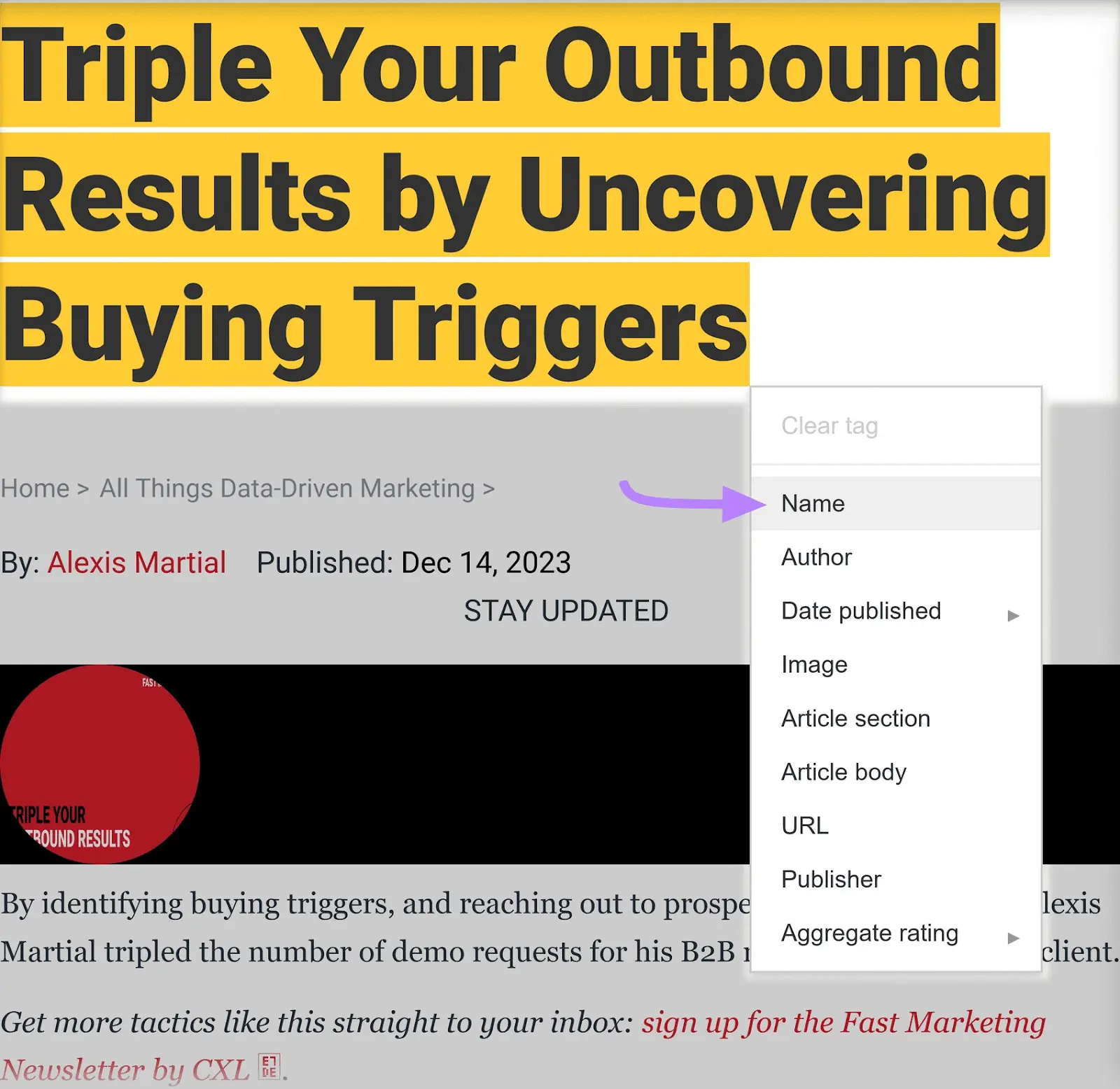
The headline will then appear as “Name” in the right-side panel.
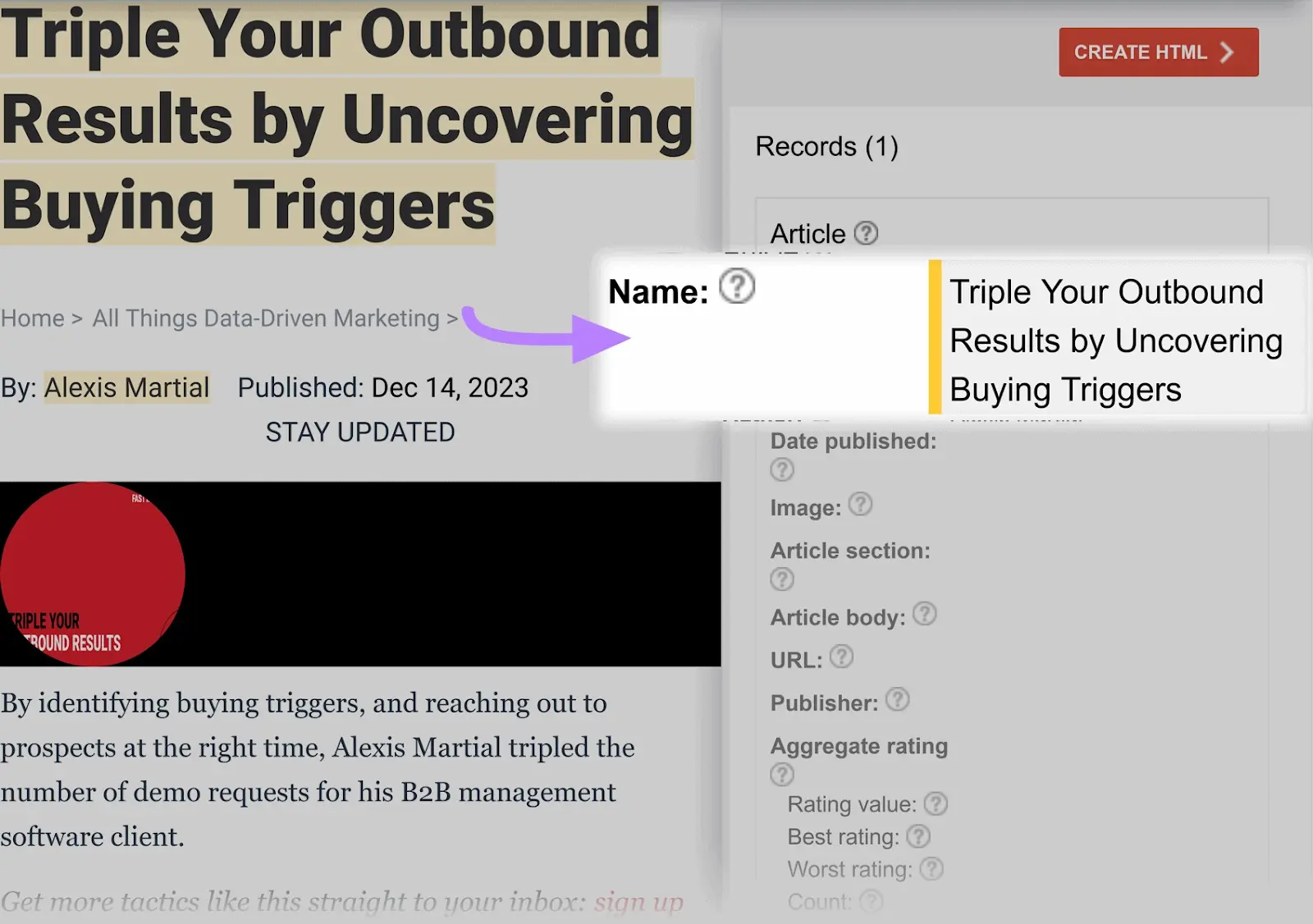
Highlight the author’s name and pick “Author” as the data item.
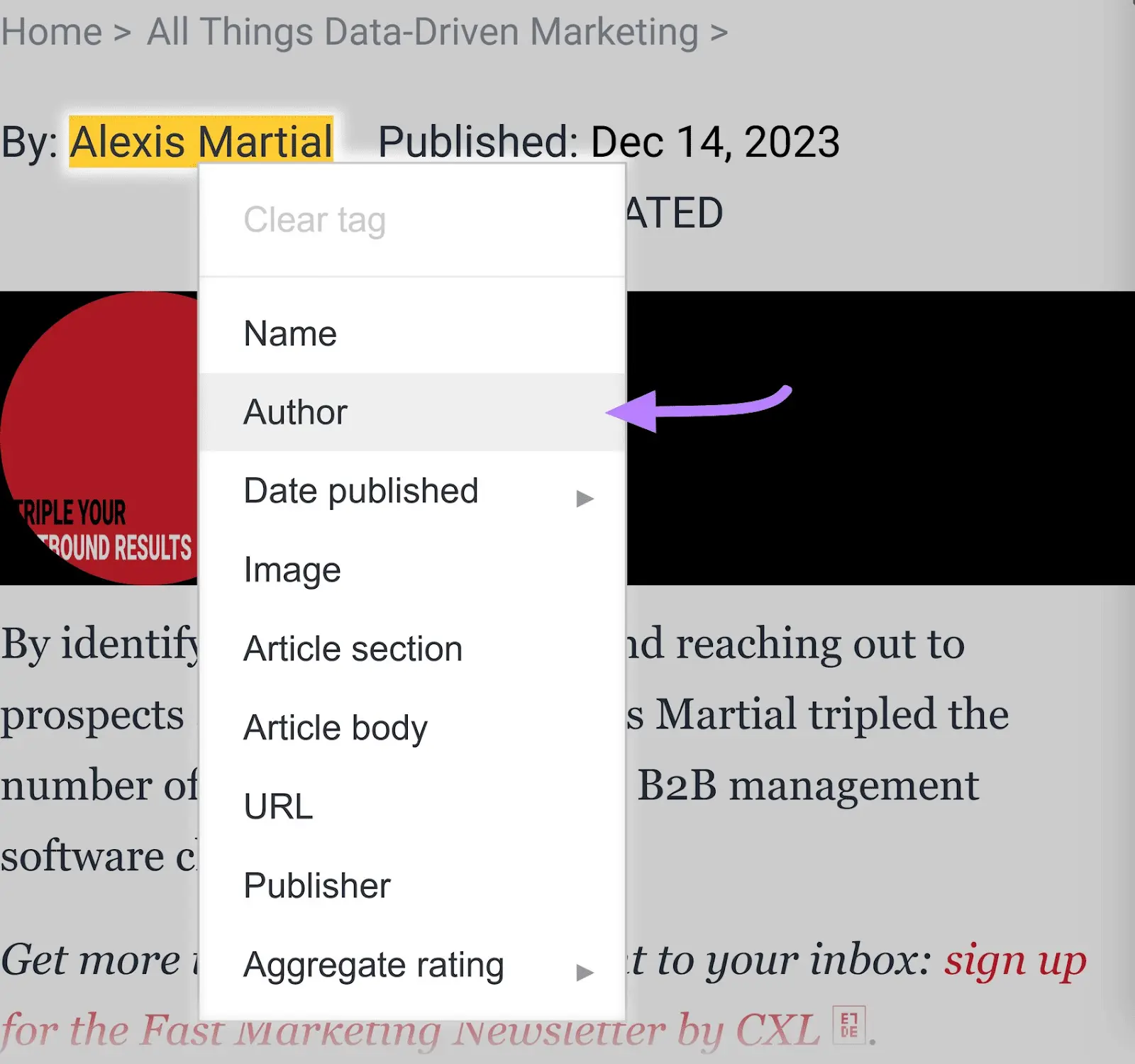
The author’s name will be listed on the right as well.
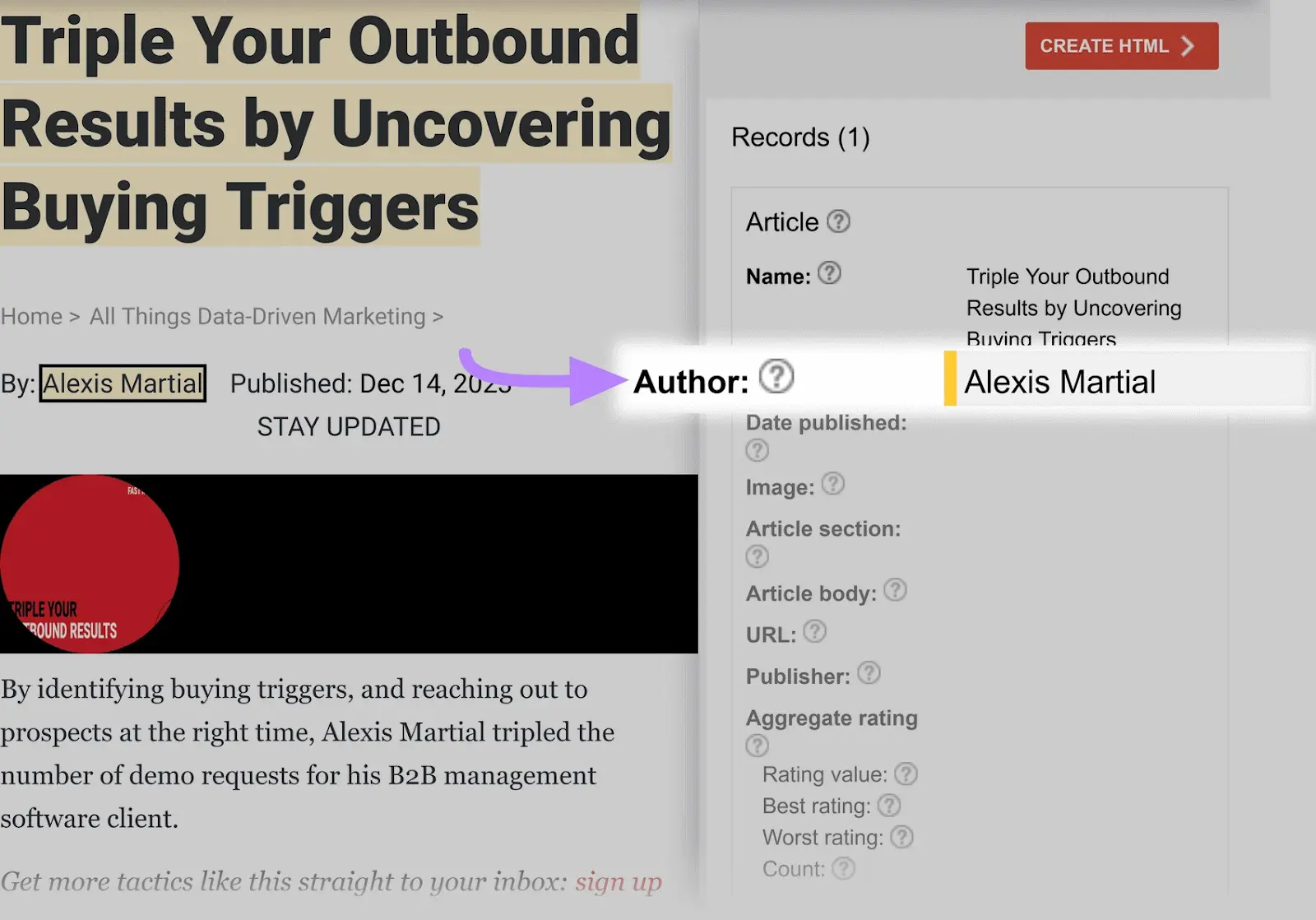
Continue tagging as many relevant properties as fit your content.
3. Generate the HTML
Once you’re done, click the “Create HTML” button at the top right.
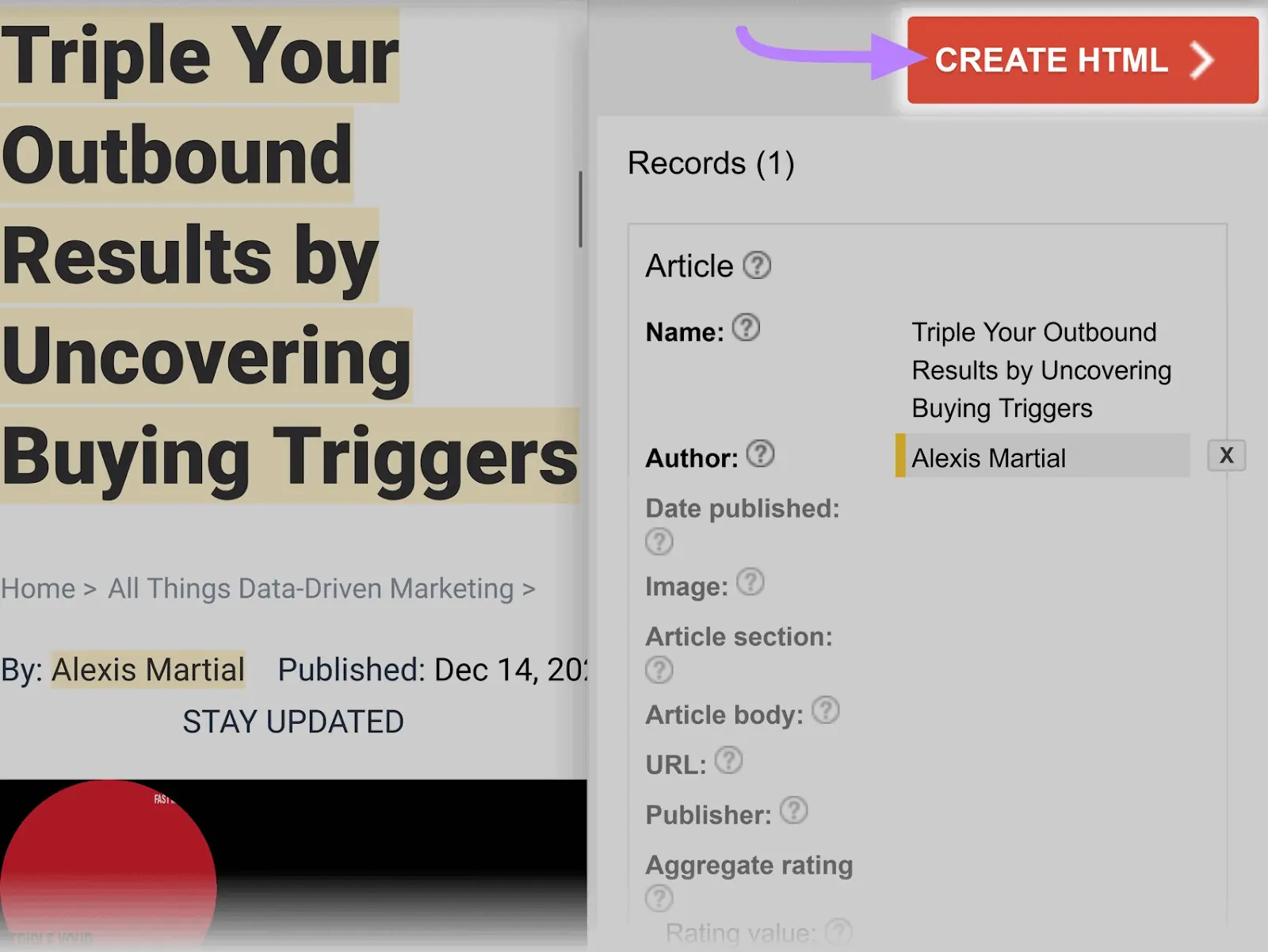
By default, the tool provides JSON-LD markup (recommended by Google), but you can change to Microdata using the dropdown menu if desired.
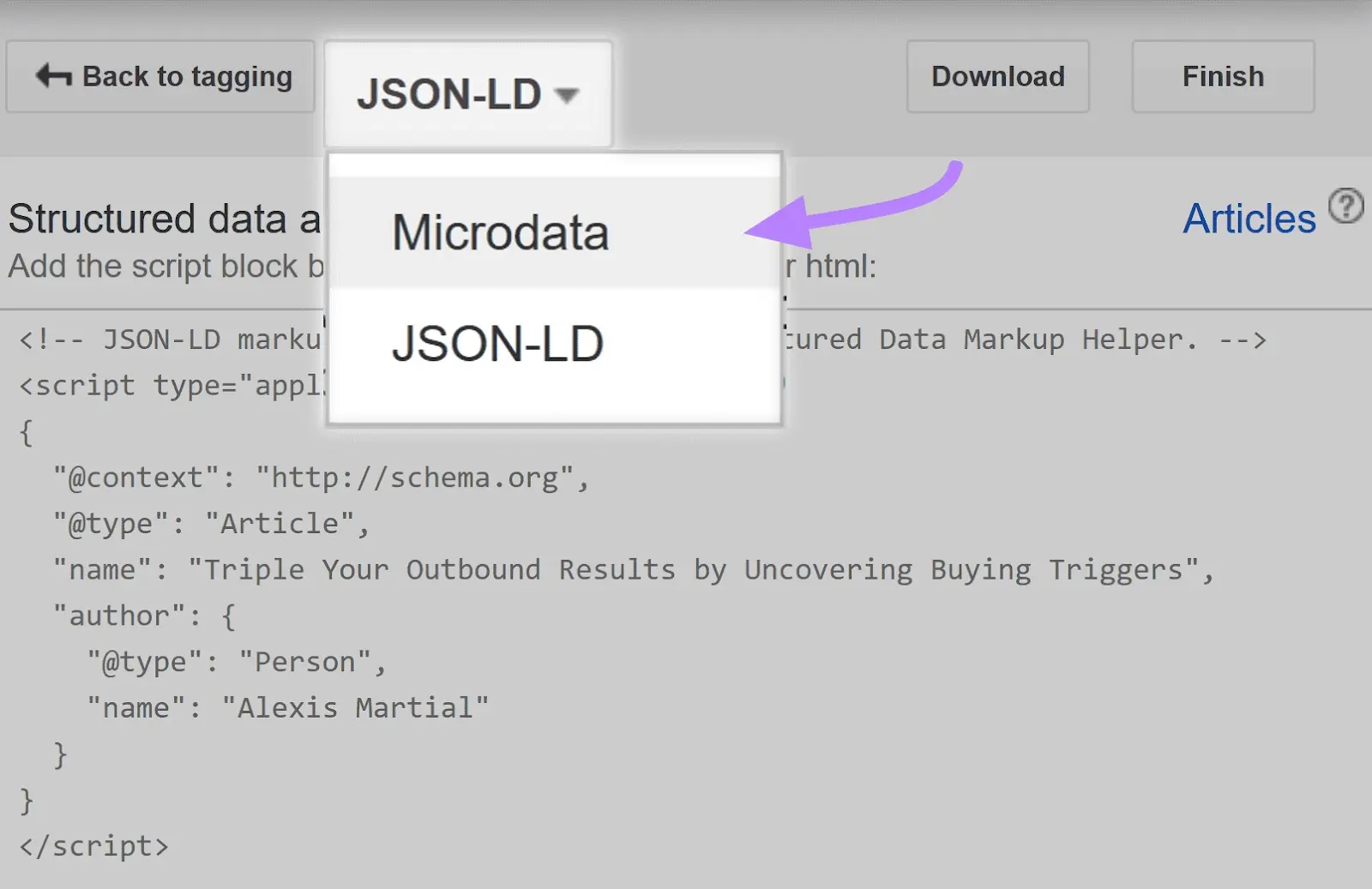
4. Add the Schema Markup to Your Website
Copy the generated code and add it to your webpage’s HTML, usually within the <head> section.
The markup can be copied directly from the tool.
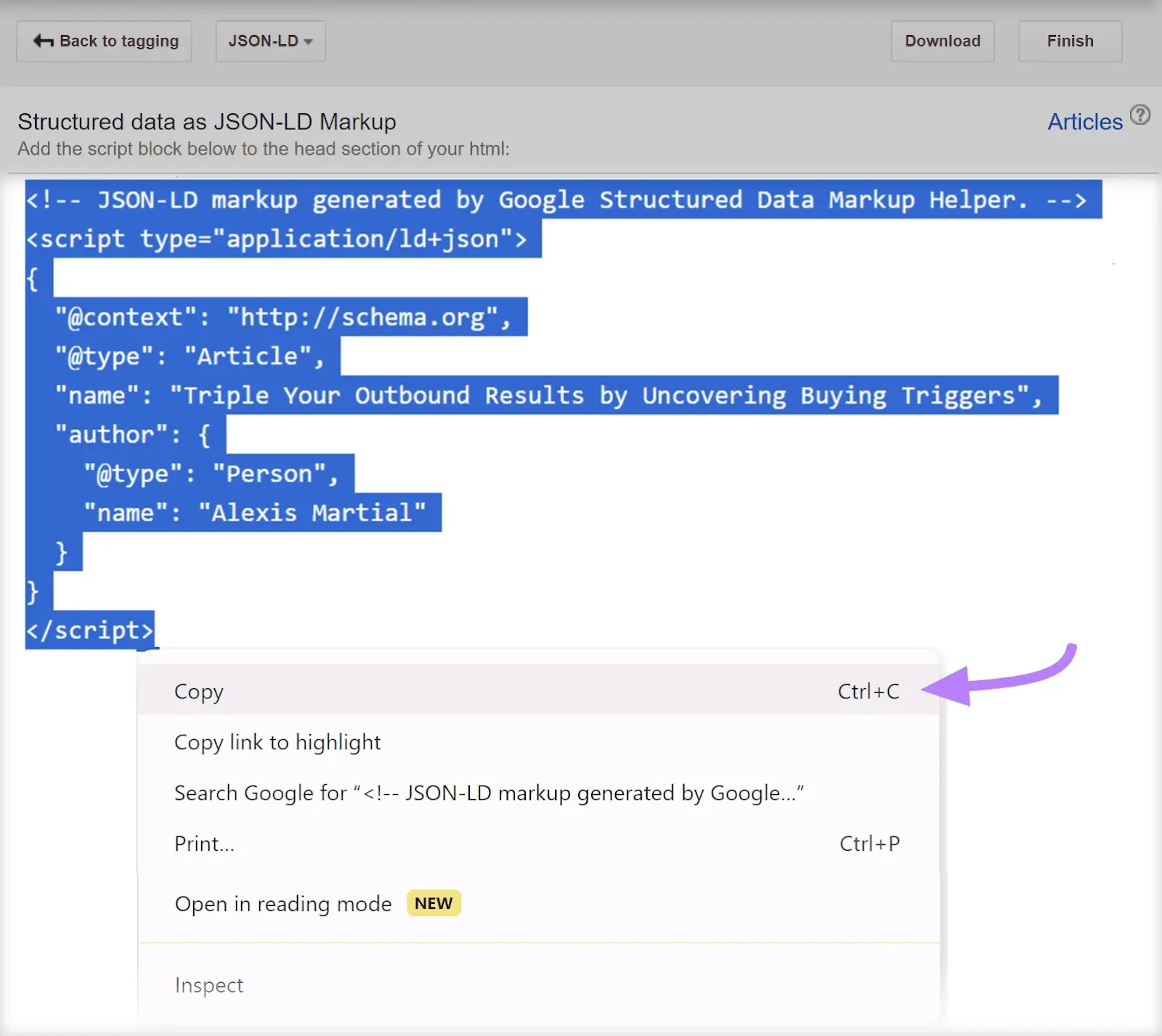
If you’re using a CMS like WordPress, plugins such as SchemaPro, Rank Math, or Yoast allow you to incorporate schema markup without direct HTML editing.
For example, Yoast SEO can produce organization schema based on business information from its settings, adding the schema automatically to your site.
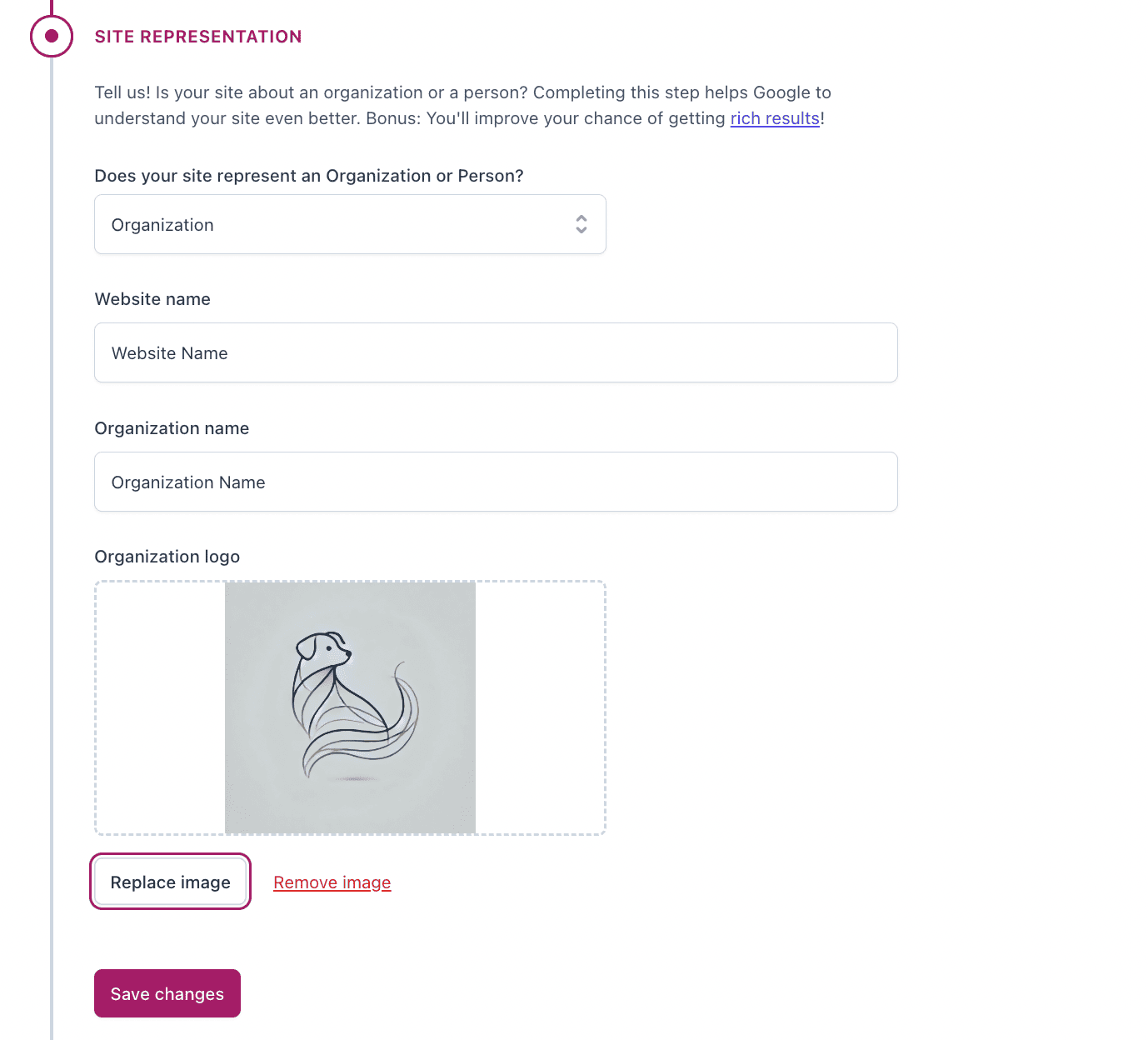
5. Validate the Markup
Use Google’s Rich Results Test to validate your markup.
Submit your site’s URL or paste the schema code to have the tool check for accuracy.

If the tool detects errors or warnings, they’ll appear on the right-hand side:
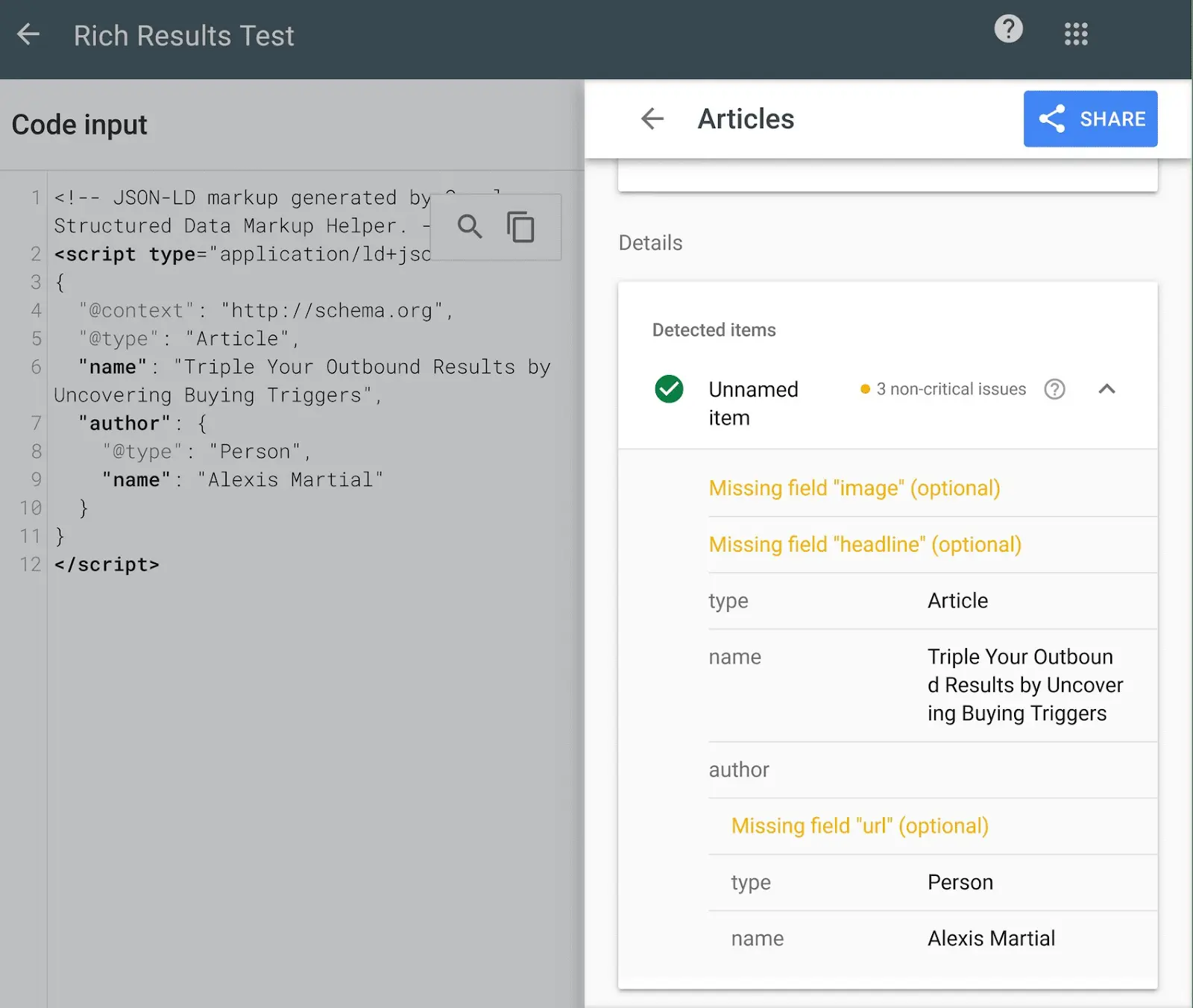
You can correct issues directly on the page and retest your schema as needed.
After making edits, click the “Run Test” button at the bottom:
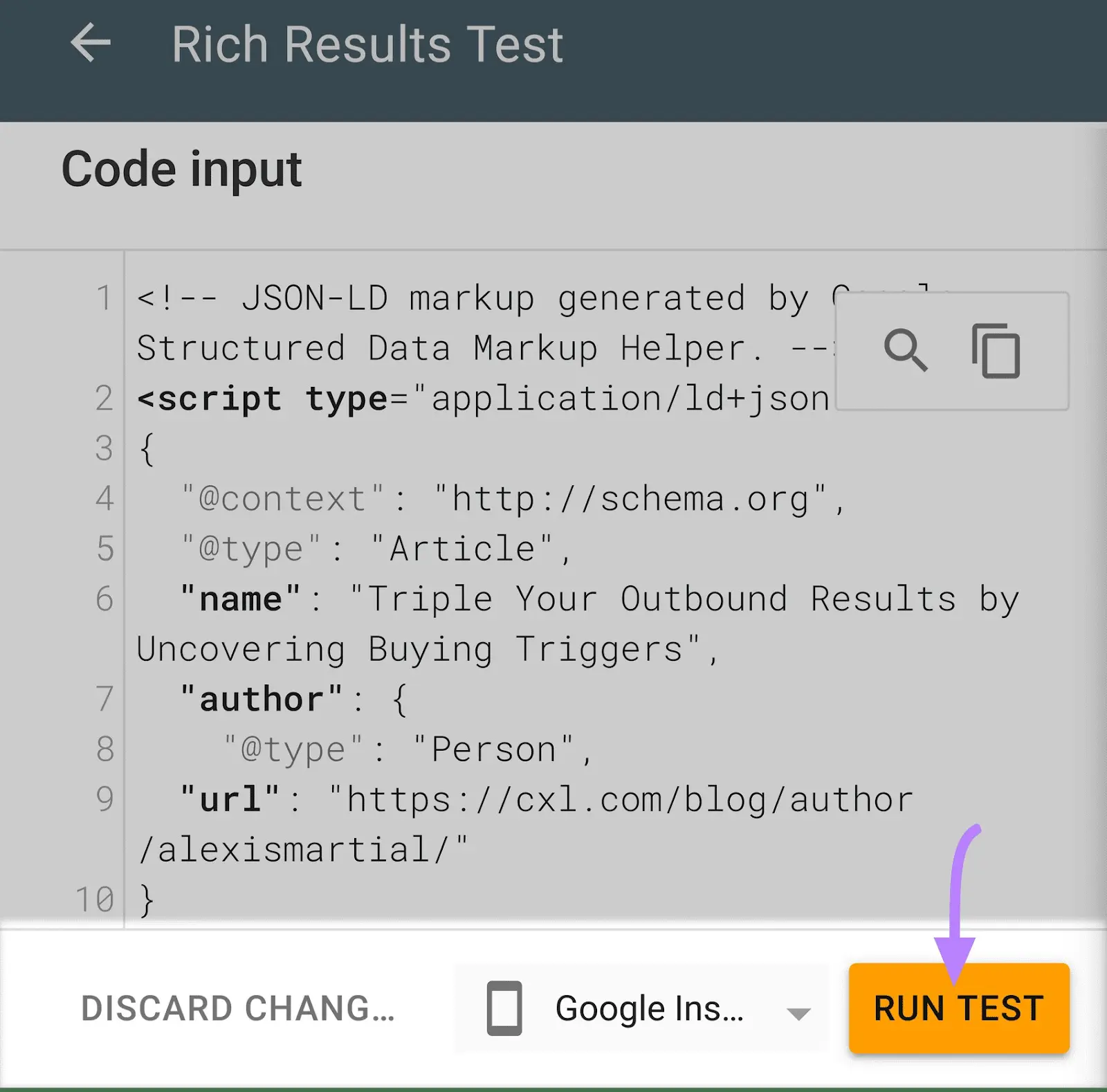
Schema Markup Best Practices
To maximize the benefits of schema markup and follow Google’s structured data guidelines, keep these best practices in mind:
- Prioritize high-value pages: Add schema to important pages such as products, reviews, articles, and local business listings, as these are more likely to be eligible for rich results
- Apply relevant schema: Ensure the markup you choose accurately describes the content of your page
- Keep data current: Stay on top of updates for details that change often, such as prices or business hours
- Include detailed information: Take advantage of all provided fields; for instance, local business schema can also cover payment methods and location info
- Stay consistent: Match your schema details with your listings on Google Business Profile, social platforms, and across the web
- Use specific types: Where possible, opt for the most precise schema available (e.g., “Restaurant” instead of “LocalBusiness”)
- Always run tests: Schema with errors can trigger a structured data manual action from Google, affecting eligibility for rich results—while it won’t impact your ranking, it could limit your site’s visibility
Check Your Website’s Schema Markup
Regular reviews of your site’s schema markup help maintain accuracy and function.
Automated site audit tools can help identify and resolve schema issues throughout your website.
Get started by initiating a full website audit.
Once complete, find the “Markup” section in the “Overview” tab, and click “View details.”
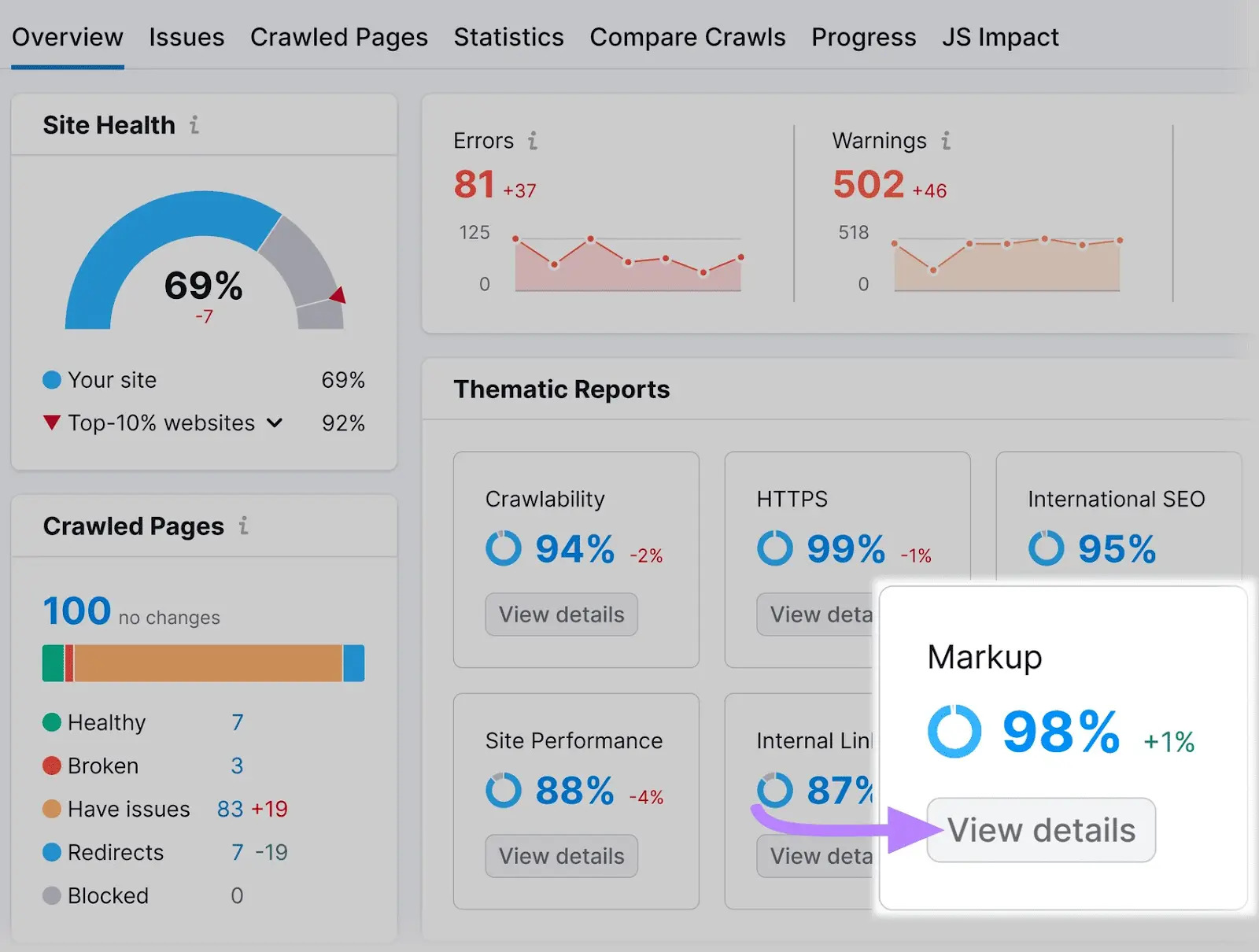
This will display a markup score showing how much of your schema is valid versus having errors. Higher scores mean fewer issues.
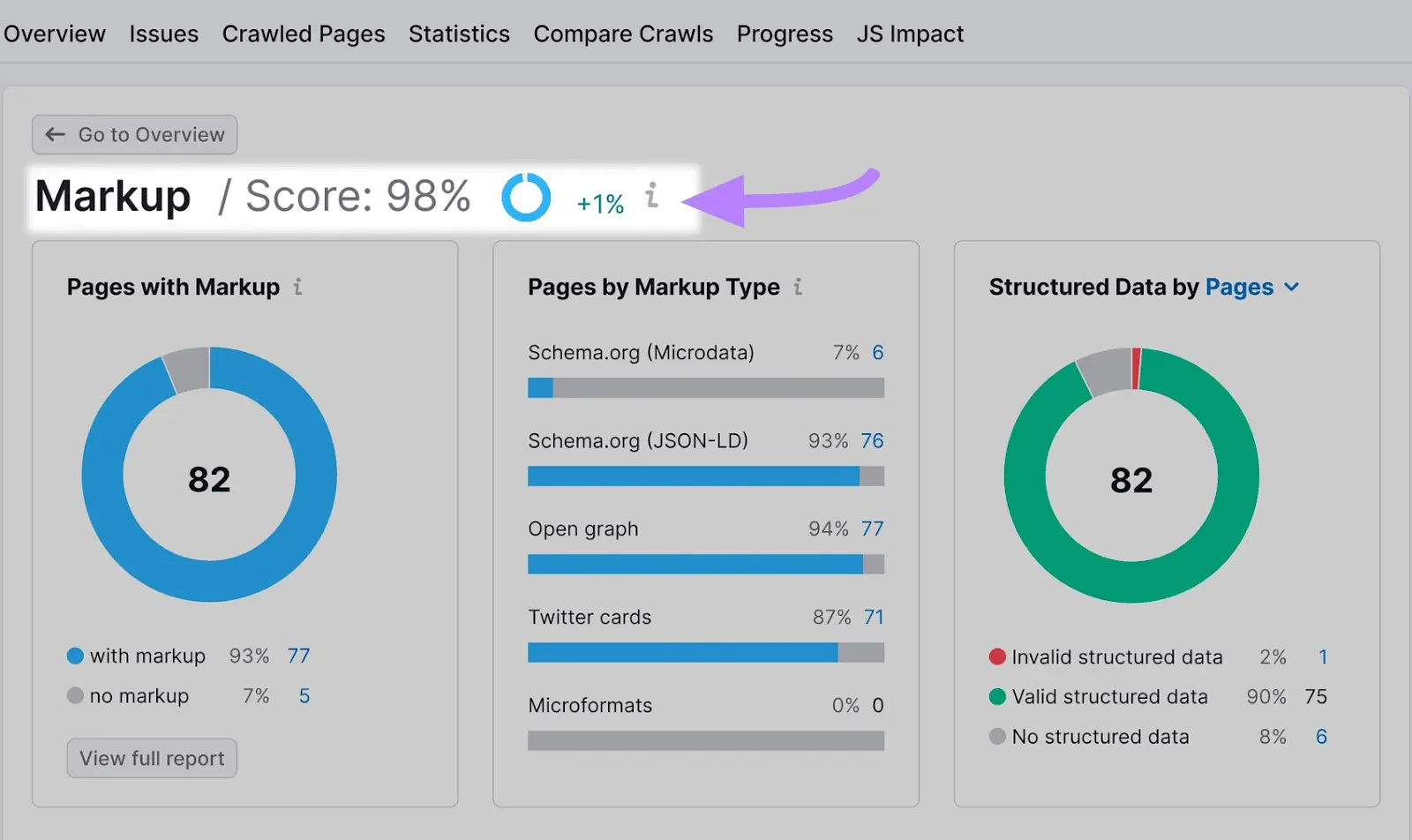
To drill into specific errors, scroll down to “Structured Data Items.”
Select “View all invalid items” for a complete list.
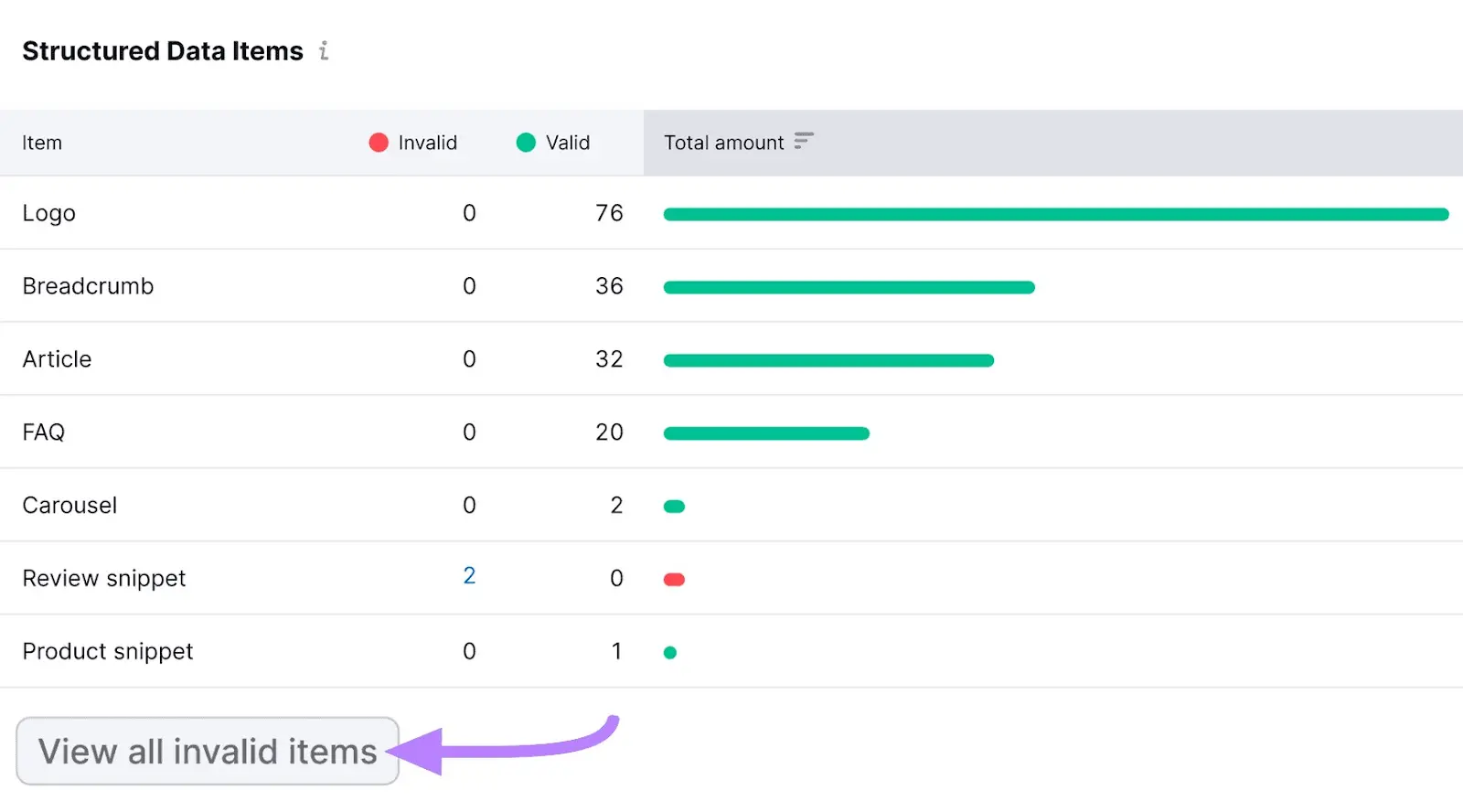
Click a field in the “Affected Fields” column for details about a particular page’s issues.
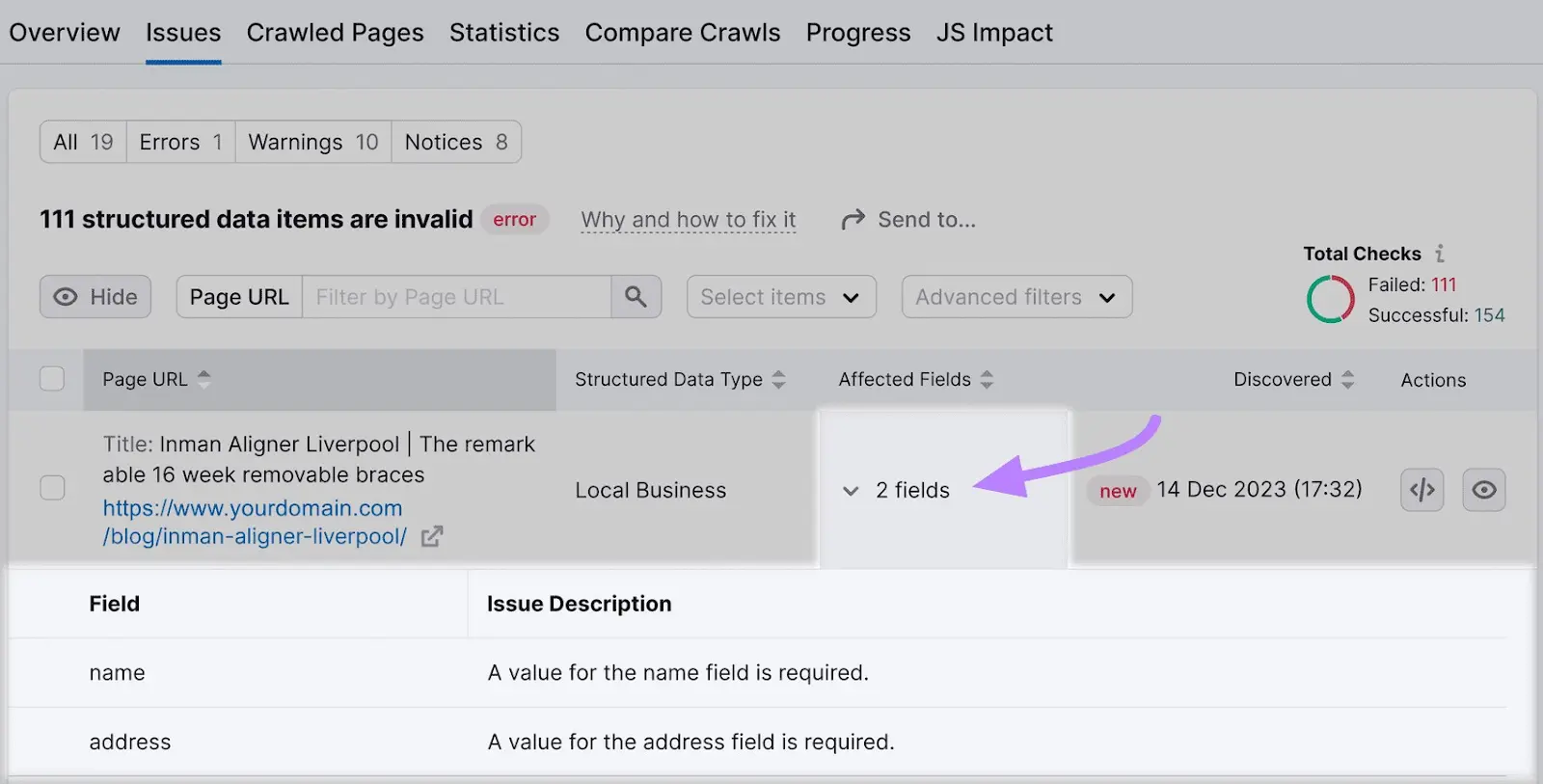
If you find errors, revisit the Structured Data Markup Helper to generate new markup and use the Rich Results Test to validate your changes again.
Advanced Benefits of Schema Markup
Beyond the obvious advantages like rich snippets, schema markup can help search engines deliver more precise answers in voice search and power advanced search features such as carousels, FAQs, and HowTo results. For example, properly marked-up event pages might appear in Google’s Events carousel, and recipes can qualify for step-by-step instructions in search results or on smart devices.
As artificial intelligence and machine learning become more integrated in search, schema markup continues to help ensure your content is machine-readable and ready for future innovations in search and discovery.
Additional Examples of Schema Types
- FAQ Schema: Adding FAQ schema enables the display of questions and answers directly in the search results, attracting more qualified traffic.
- HowTo Schema: Step-by-step guides can leverage HowTo schema to enable interactive instructions and visual results, especially useful for educational content and tutorials.
- Event Schema: When events—like webinars, concerts, or conferences—use event schema, Google may display details such as date, time, and location prominently in Search and Maps.
- Recipe Schema: Recipe markup allows for rich snippets like cooking time, ingredients, ratings, and even video instructions, significantly improving exposure for food blogs and culinary sites.
- Breadcrumb Schema: Implementing breadcrumbList schema enables search engines to display user-friendly navigation links within search results, improving both CTR and site structure clarity.
Common Pitfalls and How to Avoid Them
- Overusing or Incorrectly Applying Schema: Marking up hidden or misleading content, or using schema types that don’t accurately represent the page, can result in manual actions from Google. Always ensure your structured data reflects visible, user-facing content.
- Neglecting Updates: Failing to keep schema up to date—such as not updating out-of-stock product details—can mislead users and damage trust. Aim for regular reviews, especially on product and event pages.
- Missing Required Properties: Some types of schema have required fields (like
nameordatePublished). Missing these can prevent your markup from being eligible for rich results. Always reference the latest Schema.org specs or Google’s guidelines for required and recommended attributes.
Monitoring and Measuring Schema Impact
After implementing schema, monitor Google Search Console for “Enhancements” reports. These indicate how many valid, invalid, or warning-rich results your pages have and track impressions and clicks for structured data-driven features (like FAQs or reviews). Correlating these data with changes in click-through rates or search visibility can help quantify the ROI of structured data.
The Future of Schema Markup in SEO
Schema markup is evolving alongside the broader web. New types and properties are regularly added to Schema.org releases. Keeping up to date with these changes allows SEOs and site owners to benefit from the latest features and stay ahead in a competitive digital landscape. Enhanced integrations with AI and new Google Search features mean that investing in robust structured data is likely to offer increasing value over time.




